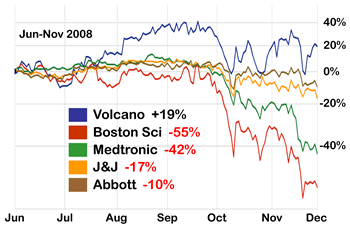![]()
<< To Homepage >>
<<Archives>>
September-December 2008 Archives: December 2, 2008 -- 8:20pm EST Volcano Corporation: Intravascular Imaging Ascending
It was the mid-80's, and I, optimist that I was/am, was certain that this new way of visualizing the interior of the coronary artery would lead to a breakthrough in treatment. My opinion was validated -- it just took a couple of decades.... The product, at that time manufactured and marketed by a company named CVIS, was ultimately acquired by Boston Scientific. A competing IVUS technology was developed by Endosonics, which was purchased by Jomed, and which ultimately was acquired by Volcano Corporation. So, today in 2008, we have a duopoly in the IVUS field: Volcano and Boston Scientific. But, while Boston Scientific has a wide-ranging array of medical devices, from stents to ICDs, Volcano has concentrated solely on the development and implementation of intravascular technologies, such as IVUS, Fractional Flow Reserve (FFR), OCT, VH-IVUS and forward-looking IVUS. And to Volcano's credit, the two currently-approved areas, IVUS and FFR, are proving to be not just helpful adjuncts to percutaneous interventions, but critical tools to improving outcomes. And subsequently, profit centers for the company. A quick look at this recent history of stock prices tells part of the story. Compared to its price six months ago, Volcano actually has increased its value by 19% -- this, in the midst of the worst economic meltdown since the Depression. Meanwhile, the four major stent manufacturers have suffered significant downturns, the worst being Volcano's chief competitor, Boston Scientific.
There are a number of reasons why Volcano has been performing so well -- many of them business decisions that we will not get into here. But the interesting facts for patients are that a technology that allows cardiologists to see and measure inside of the artery (IVUS) provides for more accurate stent placement and expansion, and theoretically lower rates of stent thrombosis. And being able to measure the specific blood pressure passing through a suspected arterial blockage (FFR) provides data for an informed treatment decision: is this blockage causing ischemia or not? (The recent FAME study showed quite dramatically that using FFR significantly improved patient outcomes by eliminating unnecessary stent placement.) Professional interest in these technologies is at an all-time high -- at the recent TCT meeting in Washington, Volcano's evening symposium on IVUS and related technologies attracted the largest number of registrants of any evening meeting. The whole field of intravascular imaging is an exciting one. Current technologies can help target therapies for the greatest benefit. Future technologies may marry treatment with observation, opening up a new era of interventional cardiology. « permalink » « send comment » « back to top » November 30, 2008 -- 6:30pm EST Popular Press Continues to Breed Confusion
Over CT Heart Scans
Confused? Of course you are. And the correct headline depends on your point-of-view...and your agenda: a perfect example of the Rashôman effect. The study in question reports the results of an international multicenter trial (CorE 64) conducted by the team of imaging specialists at Johns Hopkins, and is titled "Diagnostic Performance of Coronary Angiography by 64-Row CT". The data originally were presented a year ago at the American Heart Association annual meeting (Angioplasty.Org covered that presentation in our article, "64-Slice CT Heart Scan Gets High Marks As Test for Blocked Arteries") and the data showed that CT angiography had very high predictive value for diagnosing coronary artery disease. The CorE 64 study was partly funded by Toshiba Medical Systems, a manufacturer of CT scanners. The accompanying and critical commentary, published by the NEJM as a "Perspective" piece, is titled, "Pay Now, Benefits May Follow — The Case of Cardiac Computed Tomographic Angiography" and is co-authored by Dr. Rita Redberg of UCSF. In this op-ed piece, Dr. Redberg continues her critique of CT angiography as being an unproven and unnecessary test -- a view that she last voiced via a June New York Times article. Dr. Redberg's disclosures show that her work is supported by the insurer, Blue Shield of California Foundation. So, on the surface, it seems to be a conflict between the imaging industry and the medical insurers. But I find that, in the case of CT angiography, this adversarial relationship is a straw man. For example, the accuracy of CT angiography could potentially eliminate many invasive angiograms, one third of which are negative, thus significantly reducing costs and complications for patients. Also, the Reuters article states categorically that "the amount of radiation received with a CT heart scan is double, triple or quadruple the exposure in conventional angiography." Perhaps that was true years ago. But today the typical CT scan is the same as or less than conventional angiography. Not so for the very often used nuclear stress test -- which in fact does expose the patient to double or triple the radiation. This is a complex subject and I will be dealing with it in more detail on Angioplasty.Org. Check the news page later this week. « permalink » « send comment » « back to top » September 24, 2008 -- 10:30pm EDT CBS Goes Radial Here's the clip (there IS a commercial at the start and finish -- hey, even CBS has to pay the rent....):
For more information, you can read Angioplasty.Org's exclusive interview with Howard Cohen and his partner Kirk Garrett in our Radial Access Center. CBS did. Late Update: CBS has also posted a followup article on its website. Good to see MSM exposure for this under-utilized technique. |


